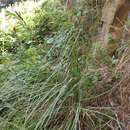zh-TW
在導航的名稱


Gahnia trifida, the coastal saw-sedge, is a tussock-forming perennial in the family Cyperaceae, endemic to southern Australia.
A herb, sedge or grass-like, with very rough leaf margins and underside. The species grows in dense tussocks, 1.5 metres and 1 metre across, with leaves over 1 metre long and drooping. It is found on white or grey sand, or clay, that may be saline. The leaf blade is inrolled from the margin on the upper surface. Stems are rigid and erect. Branchlets containing the flowering heads emerge from axils at the main bracts. This branchlet has a spike-like arrangement of numerous, yellow or brown, clusters of flowerheads.[1][2]
The species occurs in wetlands of coastal regions in Southwest Australia, South Australia, Victoria, and Tasmania. It is found at Rottnest, an island off the west coast, where it grows near the inland salt lakes. The habitat is moist, often adjacent to creeks and swamps, and may also be saline.[1][3]
The first description of Gahnia trifida was by Jacques Labillardière in Novae Hollandiae Plantarum Specimen (1805).[4][5]
Gahnia trifida, the coastal saw-sedge, is a tussock-forming perennial in the family Cyperaceae, endemic to southern Australia.
A herb, sedge or grass-like, with very rough leaf margins and underside. The species grows in dense tussocks, 1.5 metres and 1 metre across, with leaves over 1 metre long and drooping. It is found on white or grey sand, or clay, that may be saline. The leaf blade is inrolled from the margin on the upper surface. Stems are rigid and erect. Branchlets containing the flowering heads emerge from axils at the main bracts. This branchlet has a spike-like arrangement of numerous, yellow or brown, clusters of flowerheads.
The species occurs in wetlands of coastal regions in Southwest Australia, South Australia, Victoria, and Tasmania. It is found at Rottnest, an island off the west coast, where it grows near the inland salt lakes. The habitat is moist, often adjacent to creeks and swamps, and may also be saline.
The first description of Gahnia trifida was by Jacques Labillardière in Novae Hollandiae Plantarum Specimen (1805).
Gahnia trifida (con el nombre común en inglés de coastal saw-sedge) es una planta herbácea perennifolia de la familia Cyperaceae, originaria del sur de Australia.
Es una hierba, juncia como pasto, con hojas de márgenes accidentados. La especie crece en forma de matas densas, que alcanzan los 1,5 metros de altura y 1 metro de diámetro, con hojas de más de 1 metro de largo y caídas. Se encuentra sobre un fondo de arena o arcilla de color blanco o gris, que puede ser salina. El limbo es enrollado desde el margen en la superficie superior. Los tallos son rígidos y erectos. Las ramillas que contiene las cabezas con flores surgen de las axilas de las brácteas principales. Estas ramillas tienen numerosas espigas amarillas o marrón.[1][2]
La especie crece en zonas húmedas de las regiones costeras en el suroeste de Australia, Australia del Sur, Victoria y Tasmania. Se encuentra en la isla de Rottnest, una isla de la costa occidental, donde crece cerca de los lagos de agua salada hacia el interior. El hábitat es húmedo, a menudo junto a los arroyos y pantanos, y también puede ser un hábitat salino.[1][3]
La primera descripción de Gahnia trifida fue realizada por Jacques Labillardière en Novae Hollandiae Plantarum Specimen en el año (1805).[4][5]
Gahnia trifida (con el nombre común en inglés de coastal saw-sedge) es una planta herbácea perennifolia de la familia Cyperaceae, originaria del sur de Australia.
Gahnia trifida là loài thực vật có hoa trong họ Cói. Loài này được Labill. mô tả khoa học đầu tiên năm 1805.[1]
Gahnia trifida là loài thực vật có hoa trong họ Cói. Loài này được Labill. mô tả khoa học đầu tiên năm 1805.